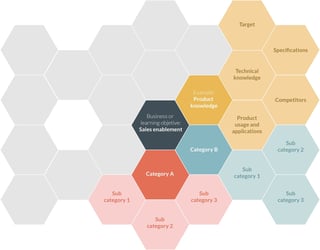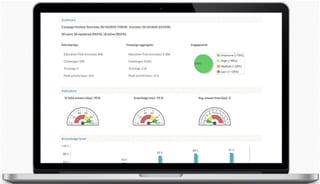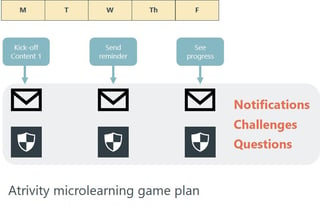Building a learning culture is the driver to transform the workplace into a culture of excellence. Employees perform with greater autonomy and confidence when equipped with relevant and curated training content. Mobile learning game apps with key information can increase knowledge by up to 30% per learner. Dedicating or transferring resources to more effective employee training impacts performance and the bottom line of any business.
Today our Customer Service Manager, Santiago shares best practices from seven years of working with organizations on employee training for local teams of 50 to global companies with 10,000+ workers.
 His experience gleans insights on how to effectively create learning programs. Clients are improving employee training outcomes with only 5 minutes a day toward building a sustainable learning culture.
His experience gleans insights on how to effectively create learning programs. Clients are improving employee training outcomes with only 5 minutes a day toward building a sustainable learning culture.
First featured guest blogger, Santiago Ubeda is a seasoned Customer Success Manager for Atrivity. He has been with Compettia since 2010 focusing on project success and client satisfaction throughout the entire customer life cycle. His role has evolved from pre-sales and consulting to overseeing customer success processes, services and projects.
Q: What are the benefits of microlearning?
A: Employees need to recall a lot of information to meet the goals set out by their managers. Every professional has to master and stay on top of basic and new concepts, processes, services, products, competition and techniques to get through daily tasks and meet their goals. Continuous employee training helps new and current staff work independently and give their best.
Microlearning meets the two main challenges learning professionals are faced with.
- The volume and variety of information
- What an employee knows today is susceptible to change tomorrow
Anyone can find 25 free minutes in a week. The problem is having those 25 minutes available in a single block of time.
Spare minutes spread throughout the day can easily be filled with small packages of training content. Our clients leverage mobile convenience and pill-sized content to keep employees aligned with company goals whether they are out on sales calls or working in a different time zone. 
Q: They say that mobile gamification apps are ideal for today’s learner. Do you agree or disagree?
A: Mobile is the tool that ensures participation in employee training. Not only do studies support this, but also, our over 5.7 million game challenges confirms it. Everyone is permanently connected and available on mobile devices to get through the day and to get things done. Our clients have seen considerable growth in learning program participation rates with our Atrivity mobile app.
Q: Which industries or uses work best for microlearning?
A: We have found that microlearning adapts well to any industry for a variety of uses. But to share our own experience, the first adopters have been pharma and retail with banking closing ranks.
Atrivity started as a reinforcement and measurement tool for strategic training initiatives like corporate training to leverage mobile learning. But we've quickly evolved to meet real market demands and growing needs.
Today our game app is widely incorporated across functional areas touching on different business processes and worflows of one-off training and continuing education:
- Onboarding: new hires go through a training itinerary covering content blocks of company history, organization, and internal processes plus job function-specific topics.
- Continuous training: based on monthly games with the training topic priorities as needed by the organization on such areas as compliance, product knowledge, sales techniques, and regulations.
- Permanent games: refresher training pills of knowledge for all those non-seasonal or one-off topic needs.

Q: Which learning areas or uses are clients using Atrivity for?
A: The areas most covered for microlearning are:
- Sales and marketing: product launch, product and category knowledge, sales process, negotiation, sales tools
- HR, learning and development: onboarding, knowledge of the company / brand, history, values, vision, organization, internal processes
- Corporate training: Regulatory topics such as compliance and risk prevention
Q: Tell us about the most successful cases that have maximized learning with Atrivity.
We've taken a look at the results of 1,100 players in 4 to 6 day games. Participants come from a range of sectors from pharma to retail and supermarket to fast food chains. Groups from 10 up to 215 employees participated in the games analyzed.
Knowledge acquisition is one of the main KPIs for training programs. When players start with a high knowledge base, upwards of 75%, increase in knowledge ranges from 10-15%. In the case of lower starting knowledge levels from 20 - 40% is where we see greater jumps in knowledge gained from 20 - 30%, and in some cases up to as much of a 50% increase.
Time is higher when challenges include more questions and when players are more highly engaged by challenging more colleagues in competition throughout the course of the day.
Here are the characteristics of the games we evaluated:
- Atrivity game length: 4 to 6 day games
- Training time per day per player: 5 - 8,5 minutes
- Participation rates: range - 53 - 100%, with an of 90% of cases studied
- Microlearning topics: compliance, policies and procedures, new products, skincare, nutrition facts, back to school sales
- Training goal: refresh and reinforce knowledge, identify and fill knowledge gaps
- Training need: link to sales performance, identify strong and weak players, team building, kick-off product sales and complement offline training
Q: How is it measured?
A: The Atrivity platform provides statistics to analyze the success of the training through:
- ratios of users registered

- active participation
- average time spent
- questions answered per player
- answer accuracy ratio per player
- knowledge increase per player
The game dashboard records game activity for insights of game evolution from start to finish.
Key game success factors:
- Influence: level of influence and motivation from the manager or game master with players is an important factor in participation rates
- Enrolment: Enrolment rates range from 40-100%. With a highly influential game administrator we would expect +75%, mid-level influence +60%, low-level +30%
- Participant time of dedication: for engagement, reinforment and retention players spend 3-7 minutes a day
- Microlearning content definition: mini, concise topics with a defined learning or business goal
- Continuity and link to intrinsic or extrinsic rewards: give value to preparation, participation and game outcomes. This will give greater value to the activity and the knowledge gained.
- Learning: ratio of success is the first time they answer the questions and the last. The difference is the improvement can vary with ratios upwards of 15% .
Q: What are the requirements and steps to setting up a mobile game?
A: Our game implementation includes 5 stages from client onboarding to post-game analysis: 1) planning 2) configuration 3) enrolment 4) game 5) analysis
- Content and calendar planning: roles, timing, participants, and content
- Configuration: duration, challenges, questions
- Communication plan: messaging and content
- Game dynamics: uploading questions and players
- Analysis: metrics for insights and game optimisation
Q: How would you set up a game for highest impact in a short period?
A: The shortest games for highest learning impact are 5-day, 2 and 4 week:
- 5-day game
- effective follow-up of short training actions like presentations, workshops
- pre-selected training material that represent key employee takeaways
- game dynamics of 3 daily challenges during 5 days
- questions are revisited up to 3 times for reinforcement

- 2-week game
- format and dynamics same as 5-day game
- leverages a mid-level content amount
- for continuity and mid-level of topic breadth or depth
- 4-week game
- ideal format for learning pills or training blocks
- breadth or in-depth topics to increase and reinforce knowledge areas
- game dynamics of 3 daily challenges during 4 weeks
- questions are revisited up to 3 times for retention and reinforcement
Q: So Atrivity is set up in challenges. What is a challenge?
A: A challenge is a set of customisable questions.
A good microlearning experience includes between 2 and 5 daily challenges.
Q: To wrap up, what is the formula to optimise engagement and promote learning 5 minutes a day?
A: Atrivity short games run from 4 days to 4 weeks featuring 3 to 7 minute a day learning experiences. Our team of game experts work with clients to define the ideal balance of challenges and repetition to reach learning outcomes linked to the client's business goals.
To explore how to apply Atrivity to your learning and development goals, talk to a game expert today.




-1.jpg)
.jpg)

